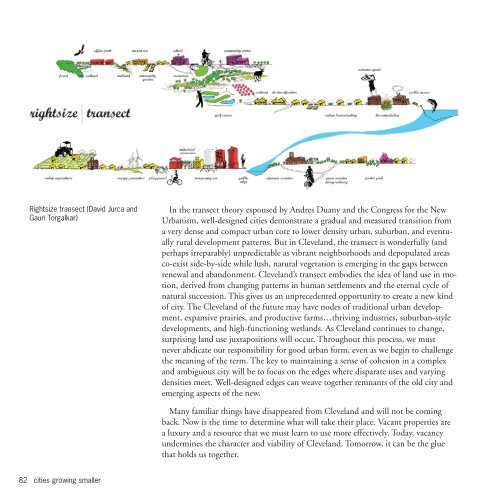cities growing smaller 71 (Terry Schwarz) - Cleveland Urban Design ...
cities growing smaller 71 (Terry Schwarz) - Cleveland Urban Design ...
cities growing smaller 71 (Terry Schwarz) - Cleveland Urban Design ...
Create successful ePaper yourself
Turn your PDF publications into a flip-book with our unique Google optimized e-Paper software.
Rightsize transect (David Jurca and<br />
Gauri Torgalkar)<br />
82 <strong>cities</strong> <strong>growing</strong> <strong>smaller</strong><br />
In the transect theory espoused by Andres Duany and the Congress for the New<br />
<strong>Urban</strong>ism, well-designed <strong>cities</strong> demonstrate a gradual and measured transition from<br />
a very dense and compact urban core to lower density urban, suburban, and eventually<br />
rural development patterns. But in <strong>Cleveland</strong>, the transect is wonderfully (and<br />
perhaps irreparably) unpredictable as vibrant neighborhoods and depopulated areas<br />
co-exist side-by-side while lush, natural vegetation is emerging in the gaps between<br />
renewal and abandonment. <strong>Cleveland</strong>’s transect embodies the idea of land use in motion,<br />
derived from changing patterns in human settlements and the eternal cycle of<br />
natural succession. This gives us an unprecedented opportunity to create a new kind<br />
of city. The <strong>Cleveland</strong> of the future may have nodes of traditional urban development,<br />
expansive prairies, and productive farms…thriving industries, suburban-style<br />
developments, and high-functioning wetlands. As <strong>Cleveland</strong> continues to change,<br />
surprising land use juxtapositions will occur. Throughout this process, we must<br />
never abdicate our responsibility for good urban form, even as we begin to challenge<br />
the meaning of the term. The key to maintaining a sense of cohesion in a complex<br />
and ambiguous city will be to focus on the edges where disparate uses and varying<br />
densities meet. Well-designed edges can weave together remnants of the old city and<br />
emerging aspects of the new.<br />
Many familiar things have disappeared from <strong>Cleveland</strong> and will not be coming<br />
back. Now is the time to determine what will take their place. Vacant properties are<br />
a luxury and a resource that we must learn to use more effectively. Today, vacancy<br />
undermines the character and viability of <strong>Cleveland</strong>. Tomorrow, it can be the glue<br />
that holds us together.


